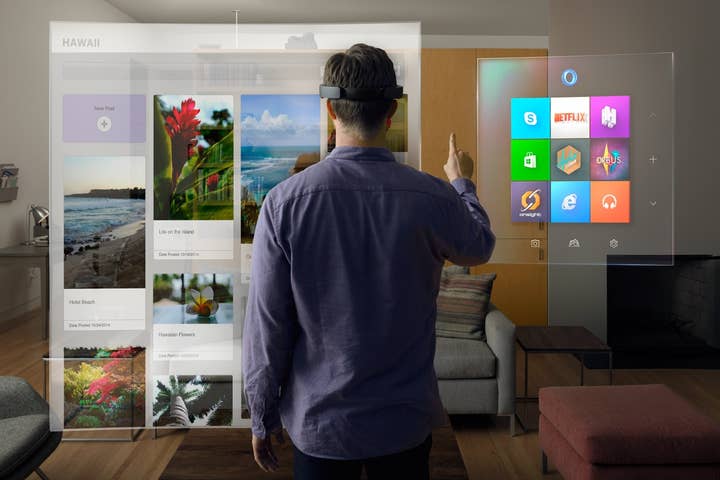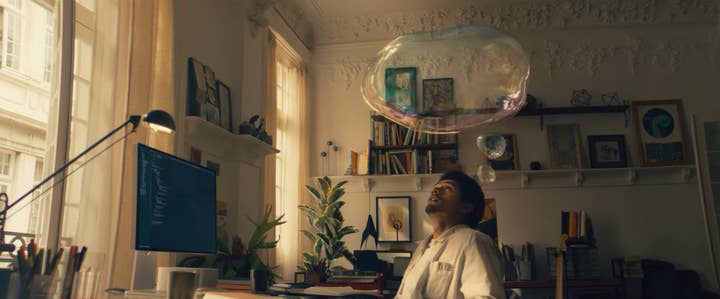Apple's AR headset suffers from a lack of vision | Opinion
The Vision Pro can improve on the tech and design of HoloLens and Magic Leap all it wants, but it still shares the same fuzzy idea about what it's actually for
Apple's WWDC keynote began with a man at a computer, programming. He has a thought that appears as soap bubble coming out of his head, but before he can act on it, it drifts out the window and down the street.
The man chases the bubble around the city, over and around obstacles, through a fountain, up to a roof top. As he chases his bubble, it seems nearly everyone around him is chasing a bubble of their own to humorously little success.
When our Apple-using hero reaches the rooftop and sees the bubble return back to earth sinking just out of view, he does not hesitate, making a suicidal jump into nothingness in the hopes that the bubble will support him.
As he wraps his arms and legs around the bubble, it reacts like an inflatable pool toy, dropping a few feet under the man's weight and then rising back up as the man delivers an exuberant smile.
But it keeps rising far above the city as the slogan "Dream it. Chase it. Code it." appears on the screen as the camera pans away and the music drifts out.
The vignette seems to be an admission that yes, the Apple Vision Pro is indeed Apple chasing the augmented reality bubble.
But unlike the poor fools who find themselves pinned against their car's windshield by the bubble or struggle to force it somewhere it simply won't go, Apple's pursuit will be successful. (Perhaps too successful, if we want to guess at the man's expression when the thrill of the chase wears off and he starts to wonder how he will safely return to earth.)

It's surprisingly self-aware for a bit of big tech marketing hype. It's also a little on the nose. But then again, so is the product.
From what was shown and various hands-on assessments from the likes of TechCrunch, the Vision Pro is a demonstrable step up from previous AR efforts like HoloLens and Magic Leap. There seem to be a bevy of clever design choices addressing common complaints with the older tech, offering an overall superior product at a steep price point, but one at least in the same gated community as its predecessors.
(Apple Vision Pro will start at $3,500, while the first HoloLens headsets cost $3,000 and Magic Leap went for $2,300.)
But despite all the improvements, the Vision Pro lacks a vision of its own. And as much as the HoloLens and Magic Leap were hurt by technical and marketing issues, the more important factor behind their commercial fates was that they lacked a clear idea of what need AR was actually filling for people.
Go back and watch the early HoloLens and Magic Leap marketing videos. Much like the Vision Pro reveal, they promise a mix of productivity and entertainment, a step toward the Star Trek Holodeck, but one where you can ask the computer to bring up Excel. Another thing they have in common is how intent they are at turning the cinematic techno-wizardry of Minority Report's gesture-based interfaces into reality.

Apple's Vision Pro seems to address a number of shortcomings in the execution of this augmented reality vision, but the vision itself is essentially identical.
(Well, not entirely. I will give Apple credit for envisioning not just the Minority Report hand gestures, but the Minority Report lonely sad dad watching videos of his family as well.)
The iPhone, the original world-changing innovation people bring up as a perfect counterpoint to Apple doubters, embodied a vision of a world where everyone had a fully capable computer that could fit in their pocket. The iPhone was not the first product built around that vision, but the touchscreen solved key problems about screen size and interface that had held back prior smartphone efforts.
"When I watch these commercials promising to let me put virtual screens all around my house... I don't see a vision on [the iPhone's] scale."
And the vision itself – a computer in every pocket – promised not just a seismic shift in the way people lived, but one that offered concrete benefits to them they would be eager to take advantage of.
When these AR devices promise to let me put virtual screens all around my house, or read my environment and place virtual items around the furniture sensibly, I don't see a vision on that scale. I see companies promising a seismic shift in the way people live, but without the same concrete benefits.
I see a new way to work with Microsoft Office, but one that requires me to wear a headset that could be annoying or uncomfortable in a dozen different ways, from the weight of the thing on my neck to the tethered strap hanging down my shoulder. And while replicating a multi-monitor setup in a smaller physical workspace sounds like a nice benefit, it's not computer-in-your-pocket big.
And I can see how the Vision Pro and its AR ilk could be great for some professions, like architects wanting to give clients a sense of what the finished product should feel like, but most of those applications I've seen proposed have been done (or could be) every bit as well with existing VR headsets. Beyond that, there are enterprise uses that might be decently sized niches, but we're not exactly replacing the keyboard, mouse and monitor computer interface here.
I was most intrigued at the idea of watching stereoscopic 3D movies with the headset. But given stereoscopic 3D displays were another this-will-change-the-world-like-the-iPhone boondoggle that didn't pan out, that's both a testament to Apple's ability to market things and another red flag about the vision at the heart of this thing.
Beyond that, some of Disney's hypothetical assortment of interactive experiences may theoretically be possible to create in time, but would require an incredible investment the company almost certainly isn't going to be making, especially just a couple months after shutting down a metaverse division that had been tasked with making exactly those kinds of new experiences.
And as for games? Forget about it. Apple certainly did. The best it could come up with for a Vision Pro gaming application was to play Apple Arcade games on a virtual screen using a PS5 controller.

In some ways it's a refreshing change from Microsoft and Magic Leap's over-the-top promises of Minecraft and first-person shooters based on your living room or office cubicle farm. I'm actually glad Apple didn't pull that one out as it always struck me as devaluing designers who actually create game worlds to suggest that their work could be adequately replaced by whatever clutter we have lying around us at any given time.
Any other company stumbling into a windfall like Apple did with gaming would lean into it and make it a priority. But Apple has remained uninterested in games, happy to coast off the 30% it skims from other developers' revenues on the App Store without so much as trying to make games itself.
Whatever gaming applications you think the Vision Pro may have, they don't appear to be front-of-mind for Apple
Whatever gaming applications you think the Vision Pro may have, they don't appear to be front-of-mind for Apple. That's not to say it can't happen; after all games were absent from Steve Jobs' keynote announcing the iPhone, and we all know what happened with that.
But the Apple of 2007 hadn't made a killing in games, and without an App Store on the iPhone for the first year, it didn't have a clear way to monetize them.
These days, Apple is getting 62% of all its App Store revenue from games. It's very well aware of how much money there is in video games, and how a new category of device could benefit from a gaming audience. And the only use case it could offer was sitting on your couch playing a mobile port of a console game with some other company's controller in your hand.
There are of course, other non-trivial concerns: the cost, the comfort, the two-hour battery life that isn't even enough to watch movies Apple featured like Avatar: The Way of Water or Everything Everywhere All At Once, the friction of needing to put on a headset, and how isolating the experience is, for starters. Some of those could get better over the years, while others seem more inherent to the very concept of an AR headset.
But if improvements are going to come, I think the early versions of the hardware need to show potential. They need to articulate Apple's spatial computing vision in a concrete way that shows it is a vision worth sharing, worth chasing.
There's still time for Apple to show that, but from what they showed at WWDC, Vision Pro looks to me like yet another in a growing class of admittedly neat technology that promises a radically different future, but fails to show how we get from here to there, or why we would want to get there in the first place.
After reflecting on yesterday's showcase, the vision I keep seeing in my head is our brave bubble-chasing hero discovering just how insubstantial the object of his pursuit is as he crashes painfully back to earth.

